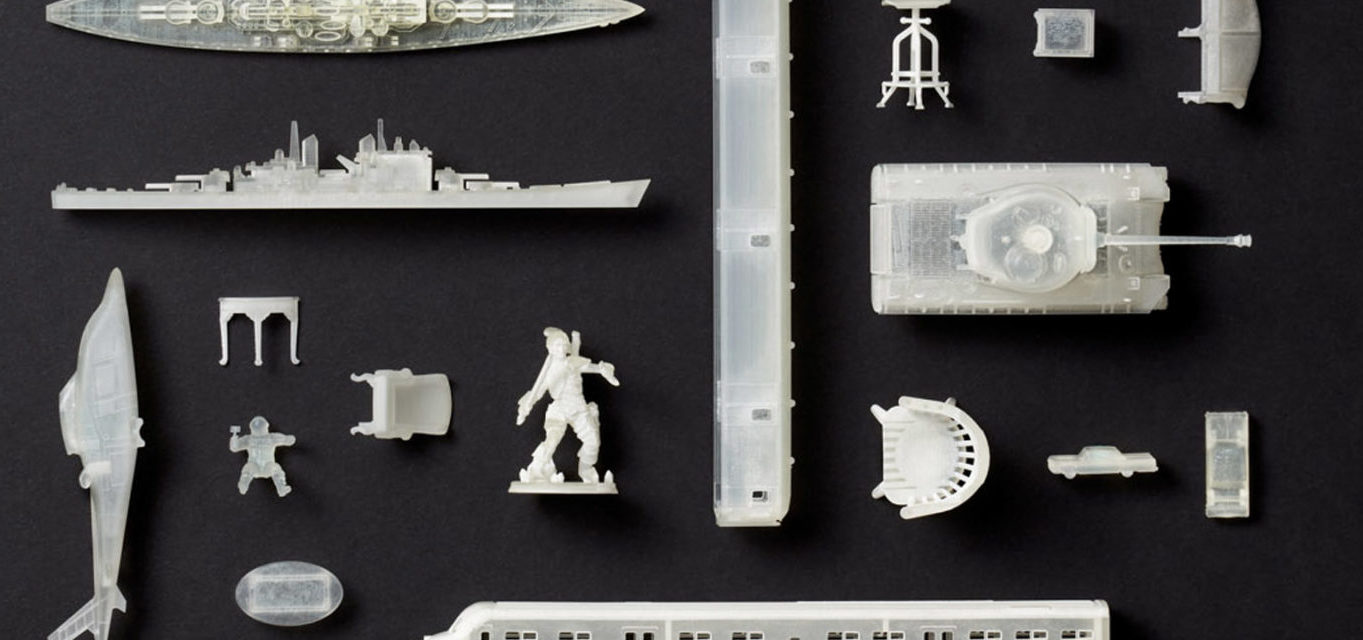
Complex, personalized designs are a big draw for turning to 3D printing for creating scale models, miniature sets, and other uniquely detailed products. Selecting the right material for a part or product is key to ensuring these detailed models take shape exactly as planned. So when would Fine Detail Plastic material be a good fit for your models? Let’s dive into this exciting material choice!
Fine Detail Plastic
Starting at the start: Fine Detail Plastic is an acrylic 3D printing material used in Material Jetting processes. It is also known as Frosted Detail Plastic or Resin-Based Acrylic Plastic. Formally called VisiJet M3 Crystal, Shapeways’ Fine Detail Plastic is a translucent photopolymer material that is tougher than Sandstone but more brittle than Nylon 12 [Versatile Plastic].
Scale models, miniatures, jewelry prototypes, and mold masters are some of the uses that might best benefit from using Fine Detail Plastic. Projects needing high detail and dimensional accuracy with a smooth surface can be a good fit. These capabilities also make a great fit for aesthetic models for educational, medical, and architectural applications. Thin walls can also have some translucency, offering more depth and interest to the look of a model. While the nature of the 3D printing process used can make the surface somewhat uneven in color, most people opt to paint their models.
Fine Detail Plastic may not be the best option for functional parts or parts that need to stand up to any kind of extreme conditions. It’s a relatively brittle material, better suited for visually interesting rather than kinetically intensive parts.
Material Jetting Fine Detail Plastic
The process used to 3D print Fine Detail Plastic is Material Jetting technology. Material Jetting is a relatively speedy 3D printing process that brings together photosensitive (thermoset acrylic) materials with UV light.
The Material Jetting process uses a printhead to dispense droplets of material — think of standard inkjet 2D printing processes, and “material jetting” makes sense. Ultraviolet light cures each dispensed layer to solidify the liquids into highly dimensionally accurate geometries.
Diving a little deeper, the full process requires several steps. Molten plastic is deposited onto an aluminum build platform in layers using several nozzles, essentially using a large printhead that sweeps across the build layer. After each layer is deposited, it is cured, or polymerized, by a wide-area UV lamp. The next layer is then applied and cured, and through this repeated process layers of thermoplastic build up into a model. When the 3D printing is finished, the models go from the build tray into an oven that melts away the wax support material. Next, the models get a bath in an industrial dishwasher to remove any remaining wax residues before they go inside a drying cabinet. After they dry, the Shapeways team inspects and ships the models.
Certain technologies — like PolyJet — also enable multi-material 3D printing. This is where Shapeways’ Multi-Color Polyjet capabilities come into play; on the Stratasys J750 printer, more than half a million color combinations are possible to make durable, realistic visual prototypes, medical models, and displays.
Another full-color material, High Definition Full Color, is a good choice for customers tapping into colored details for even the tiniest features in visual models. Similar to Fine Detail Plastic, this material uses the UV curing inkjet process where UV ink (CMYK, White) is cured layer by layer to produce printed models that can have more than 10 million different colors.
For single-material 3D printing, though, Shapeways uses 3D Systems ProJet MJP 3D printers with the Fine Detail Plastic.

Material Jetting Benefits
The primary benefits of Material Jetting include:
- High level of detail
- Speed
- Dimensional accuracy
- Smooth surface finish
- Strong aesthetics
Material Jetting Limitations
Some of the limitations of Material Jetting include:
- Higher material and system cost
- Part brittleness
- Low heat deflection temperature
- Waste material generation (i.e., supports)
Fine Detail Plastic FAQ
What are the design guidelines for Fine Detail Plastic?
When designing for a 3D printing project that will use Material Jetting with Fine Detail Plastic, detail is often the primary consideration. This material/technology combination can create some of the finest features, like the faces on gaming miniatures with the perfect expression or the smallest blood vessels appearing on aesthetic medical models.
Material design guidelines for Fine Detail Plastic — and all Shapeways materials — are available here. Further Fine Detail Plastic-specific information is available here.
How does Fine Detail Plastic pricing compare to other materials?
Fine Detail Plastic is priced competitively, accounting for the inherently more costly Material Jetting process.
The difference in printing technology between Versatile Plastic and Fine Detail Plastic allows more competitive pricing for Versatile Plastic. Tall and low density models are particularly more expensive to print in Fine Detail Plastic.
What finishes are available?
Smooth: This finish offers a smooth surface and high detail
Smoothest: This finish is capable of the highest detail and smoothest surface
What is the color and surface texture?
The color of Fine Detail Plastic ranges from clear translucent to yellow-tinted translucent. It utilizes a waxy support material that is dissolved after 3D printing is completed. Because the support material slightly changes the texture of the product, and isn’t applied to the entire product, you will see slight variability in texture over the surface of the model. Areas where the waxy support material supported the model during printing may also appear more white than the rest of your model.
How do I get started?
When Fine Detail Plastic is the right material for your job, upload your 3D model to Shapeways for a quote to get the project started!
Sarah Goehrke is the founder of Additive Integrity, offering dedicated editorial services to the additive manufacturing industry. She is a regular contributor for Shapeways, on the Board of Directors of Women in 3D Printing, and the Managing Editor of Fabbaloo.


